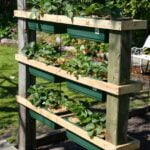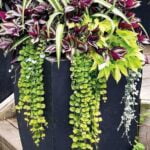Shrubs are an essential part of any landscape design, offering a wide range of shapes, sizes, and colors to enhance the beauty of outdoor spaces. In this article, we will explore shrub landscape ideas, providing tips for selecting the right shrubs, planning their layout, creative arrangements, and incorporating them into different seasons. Whether you’re looking to create a low-maintenance garden or use shrubs as privacy screens, there’s a wealth of possibilities to explore.
When it comes to designing your landscape with shrubs, selecting the right varieties can make all the difference. We’ll provide you with expert tips on how to choose the best shrubs that suit your specific needs and climate conditions. Additionally, we’ll also share design tips for planning a stunning layout that incorporates these versatile plants effectively into your outdoor space.
Furthermore, we will introduce creative ideas for arranging and grouping shrubs in unique ways to add visual interest and appeal to your landscape. With our guidance on using shrubs for privacy screens and incorporating them into existing landscapes, you’ll be equipped with all the knowledge needed to transform your outdoor space with lush greenery and vibrant colors. So let’s dive in and discover the endless beauty and versatility that shrubs bring to landscaping.
Selecting the Right Shrubs
When it comes to selecting the right shrubs for your landscape, there are a few key factors to consider. First and foremost, it’s important to take into account the climate and growing conditions in your area. Some shrub varieties may thrive in full sun, while others prefer shade or partial shade. Researching the specific needs of different shrub species will help you make the best selection for your landscape.
Another crucial aspect to consider when choosing shrubs is their size and growth habits. Are you looking for low-growing shrubs to border a garden bed, or do you need tall, upright shrubs to create privacy screening? Make sure to take into account the mature size of the shrubs you choose, as overcrowding can lead to maintenance issues down the line.
Additionally, think about the purpose of the shrubs in your landscape. Are you aiming for a burst of spring color, or are you seeking evergreen varieties for year-round interest? Do you want fragrant blooms or attractive foliage? Understanding your aesthetic preferences and overall goals for your landscape will help guide your shrub selections.
When selecting shrubs for your landscape, it’s also essential to consider maintenance requirements. Some homeowners may be looking for low-maintenance options that require minimal pruning and care, while others may enjoy spending time tending to their plants. Keep these considerations in mind as you explore different shrub options for your landscape.
To guide you further on selecting the right shrubs for your landscape here are some tips:
- Research local native species that are well-suited to your area’s climate and soil conditions
- Consider the mature size and growth habit of each shrub variety
- Think about the visual impact and purpose of each shrub within your overall landscape design
- Take note of maintenance requirements and select shrubs that align with your desired level of care
By following these tips and taking into consideration these aspects when selecting shrubs for your landscape, you can ensure that you choose the best options to enhance the beauty and functionality of your outdoor space.
Planning Your Shrub Layout
When planning the layout of your shrubs in your landscape, it’s important to consider the overall design and aesthetic you want to achieve. Here are some design tips for incorporating shrubs into your landscape:
1. Consider the size of your space: If you have a small yard or garden, opt for smaller shrubs that won’t overwhelm the area. For larger spaces, you can mix and match different sizes and shapes to create visual interest.
2. Create focal points: Use larger or more unique shrubs as focal points in your landscape design. Placing them strategically can draw the eye and add visual appeal to your outdoor space.
3. Pay attention to color and texture: When planning your shrub layout, think about how different types of shrubs will complement each other in terms of color and texture. Mixing evergreen with flowering shrubs can provide year-round interest, while combining different leaf shapes and colors can create a dynamic look.
4. Utilize borders and edges: Define the edges of your landscape beds or walkways with carefully placed shrubs. Low-growing varieties can be used as borders, while taller varieties can create privacy screens or windbreaks.
5. Think about maintenance: Consider the maintenance needs of the shrubs you choose when planning their layout. Low-maintenance options may be more suitable for some areas of your landscape, while others may require more care and attention.
By considering these design tips, you can create a well-planned and visually appealing layout for your shrub landscape ideas that will enhance the overall look of your outdoor space.
Creative Shrub Arrangements
When it comes to creating a visually appealing landscape, the way you arrange and group your shrubs can make a significant impact. By thinking outside the box and getting creative with your shrub arrangements, you can add interest and personality to your outdoor space. Here are some unique ideas for arranging and grouping shrubs in your landscape.
Layered Planting
One creative way to arrange your shrubs is to use a layered planting approach. This involves planting taller shrubs at the back of the border, medium-sized shrubs in the middle, and low-growing varieties at the front. This creates a sense of depth and dimension in your landscape, making it more visually appealing.
Colorful Combos
Another idea for creative shrub arrangements is to pair different shrub varieties that flower or produce colorful foliage at different times of the year. For example, you can plant spring-blooming shrubs alongside summer-blooming varieties to ensure continuous color throughout the growing season. Consider mixing contrasting colors for a bold and eye-catching display.
Sculptural Groupings
For a modern and artistic look, consider grouping several shrubs of the same variety together in a cluster or irregular pattern. This type of arrangement can create a sculptural effect in your landscape, drawing attention to the unique shapes and textures of the plants themselves. It’s an unconventional approach that can add an element of surprise to your garden design.
By implementing these creative shrub arrangement ideas into your landscaping plans, you can make your outdoor space truly stand out. Whether you opt for layered planting, colorful combos, or sculptural groupings, there are countless ways to utilize your shrubs to create a beautiful and unique landscape. With some thought and planning, you can transform your yard into a visually stunning showcase of natural beauty.
Shrubs for Different Seasons
Shrubs are a fantastic addition to any landscape, providing color and interest year-round. By carefully selecting the right shrub varieties, you can ensure that your outdoor space remains vibrant and inviting regardless of the season. From flowering blooms in spring to colorful foliage in fall, there are shrubs that offer beauty in every season.
Spring-Blooming Shrubs
For a burst of color as winter fades away, consider adding spring-blooming shrubs to your landscape. Varieties such as azaleas, forsythia, and lilacs are popular choices that produce stunning floral displays in a range of hues. These shrubs not only add visual appeal but also attract pollinators like bees and butterflies to your garden.
Summer-Friendly Shrubs
As the weather warms up, it’s essential to have shrubs that thrive in the summer months. Look for varieties like hydrangeas, butterfly bushes, and crape myrtles that offer beautiful flowers and lush foliage during the hottest time of year. These shrubs can bring cooling shades of blue, purple, and pink to your landscape while withstanding the heat.
Fall Foliage Favorites
When autumn arrives, certain shrub species provide stunning displays of color as their leaves change hues. Consider incorporating shrubs like burning bush, oakleaf hydrangea, and witch hazel for their vibrant reds, oranges, and yellows. These plants not only add visual interest but also signal the arrival of the fall season with their bold foliage.
With careful planning and selection, you can ensure that your landscape remains visually appealing throughout the year using these shrub landscape ideas. By strategically choosing spring-blooming shrubs, summer-friendly varieties, and fall foliage favorites, you can create a dynamic outdoor space that changes with the seasons.
Low-Maintenance Shrubs
When it comes to landscaping, not everyone has the time or energy to devote to high-maintenance plants. For homeowners with busy schedules, low-maintenance shrubs can be a lifesaver. These types of shrubs require minimal care and upkeep, making them an ideal choice for those who want a beautiful landscape without all the work.
One popular option for low-maintenance shrubs is the evergreen variety. Evergreen shrubs retain their foliage year-round, providing color and interest in the garden regardless of the season. Examples of evergreen shrubs include boxwood, holly, and juniper. These shrubs are known for their hardiness and ability to withstand various weather conditions with minimal attention.
Another great choice for low-maintenance shrubs is the dwarf variety. Dwarf shrubs are naturally compact and require little pruning or shaping to maintain their size and form. Some examples of dwarf shrubs include dwarf spirea, dwarf mock orange, and dwarf fothergilla. These smaller varieties are perfect for adding texture and structure to a garden without requiring constant grooming.
For homeowners looking to add some seasonal interest to their landscape without a lot of effort, choosing flowering shrubs that bloom repeatedly throughout the year may be the way to go. Some options include knockout roses, hydrangeas, and azaleas. These types of low-maintenance flowering shrubs provide bursts of color with minimal care, making them perfect for those with limited time to devote to gardening.
| Low-Maintenance Shrubs | Description |
|---|---|
| Evergreen Shrubs | Retain foliage year-round, require minimal care and attention |
| Dwarf Shrubs | Naturally compact varieties that need little pruning or shaping |
| Reblooming Flowering Shrubs | Varieties that produce multiple blooms throughout the year with minimal care |
Using Shrubs as Privacy Screens
Shrubs are an excellent choice for creating natural privacy screens in your landscape. Not only do they provide visual separation and a sense of seclusion, but they also add beauty and texture to the outdoor space. When selecting shrubs for privacy screens, it’s essential to consider their height, density, and growth habit. Ideally, you want shrubs that will grow tall enough to create a barrier while remaining full and bushy to block the view effectively.
One popular choice for privacy screens is the evergreen shrub. Evergreens maintain their foliage year-round, providing a consistent barrier regardless of the season. Varieties such as holly, boxwood, and yew are excellent options for creating a lush and green privacy screen. For those looking for additional seasonal interest, flowering shrubs like hydrangeas or lilacs can also be used to create a colorful and fragrant privacy barrier.
When planning your shrub privacy screen, consider the spacing between plants to ensure that they will form a dense and effective barrier over time. The distance between individual shrubs will depend on the specific variety and its growth habit. Regular pruning and maintenance will also be necessary to keep the shrubs looking tidy and well-kempt.
Using natural barriers like shrubs not only adds visual interest but also benefits local wildlife by providing habitat and food sources. Additionally, well-designed shrub screens can increase property value by enhancing the overall aesthetic appeal of the landscape.
| Aspect | Description |
|---|---|
| Benefits | Provides visual separation, adds beauty and texture, benefits local wildlife, increases property value. |
| Selection | Consider height, density, growth habit; evergreens are popular choices; flowering varieties can add seasonal interest. |
| Maintenance | Regular pruning needed; spacing is crucial for achieving an effective barrier; consider ongoing maintenance requirements. |
Incorporating Shrubs Into Existing Landscapes
Once you’ve already established the base of your garden or landscape, it can seem daunting to try to add new elements like shrubs without disrupting the existing aesthetic. However, incorporating shrubs into an already established landscape can be easier than you think with the right approach.
One tip for seamlessly adding shrubs to an existing garden is to consider the overall style and design of your current landscaping. By choosing shrubs that complement the existing plants and features, you can ensure a cohesive and harmonious look.
Another important consideration when adding shrubs to an established landscape is to think about the practical aspects of maintenance and care. Make sure to choose shrub varieties that will thrive in your specific climate and soil conditions, as well as ones that won’t require excessive maintenance or upkeep. This will help ensure that your new shrubs integrate seamlessly into your existing landscape without creating extra work for you.
Incorporating shrubs into an established garden or landscape also requires careful planning and placement. Take note of any empty spaces or areas that could benefit from some added greenery or visual interest.
You can use shrubs strategically to fill in these gaps while also adding texture, color, and depth to your existing landscape design. With the right selection and placement, adding new shrubs can enhance the overall appeal of your garden or landscape without clashing with what’s already in place.
Conclusion
In conclusion, shrubs are an incredibly versatile and beautiful addition to any landscape. Their ability to provide year-round color, act as natural privacy screens, and require minimal maintenance make them a popular choice for homeowners and professional landscapers alike. With the right selection and planning, shrubs can truly elevate the aesthetic appeal of any outdoor space.
When selecting the right shrubs for your landscape, it’s important to consider factors such as the climate, soil conditions, and desired maintenance level. By taking these aspects into account, you can ensure that the shrubs you choose will thrive in their environment and continue to enhance your landscape for years to come.
Whether you’re looking to create a cohesive layout with traditional shrub groupings or seeking out creative arrangements for a more unique look, there are endless possibilities for incorporating shrubs into your landscape design. From vibrant spring blooms to rich fall foliage, there are plenty of options for shrub varieties that will provide visual interest throughout the year.
Overall, by considering all of these factors and implementing smart shrub landscape ideas, you can transform your outdoor space into a lush and inviting oasis.

Welcome to my gardening blog! I am passionate about plants and enjoy sharing my knowledge and experiences with others. In this blog, I will write about everything related to gardening, from tips on how to get started to updates on my own garden projects.





